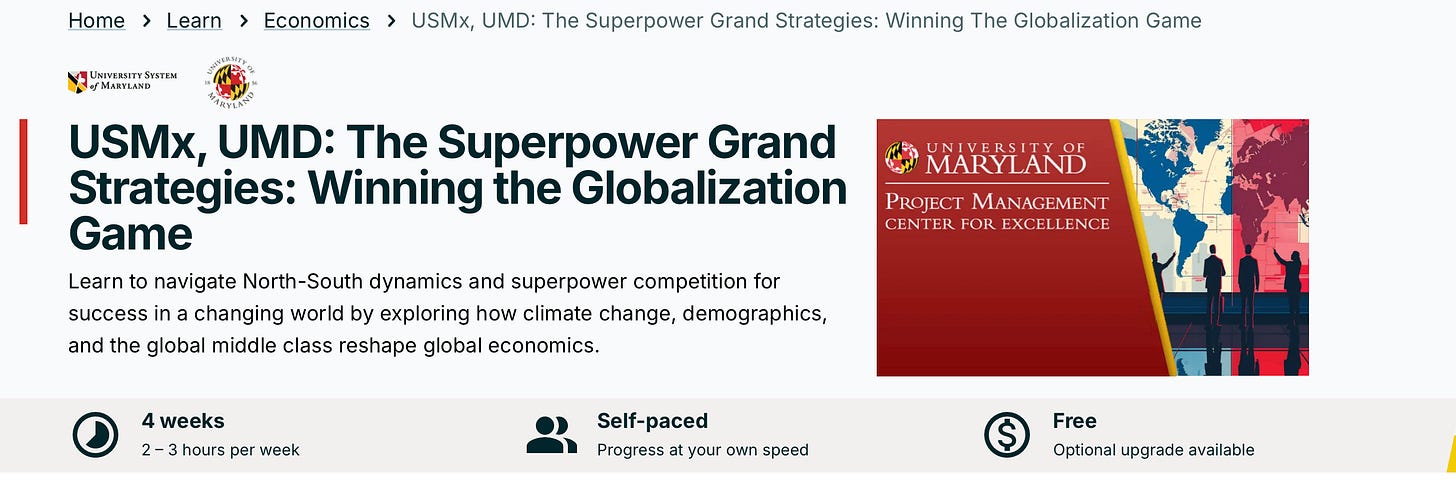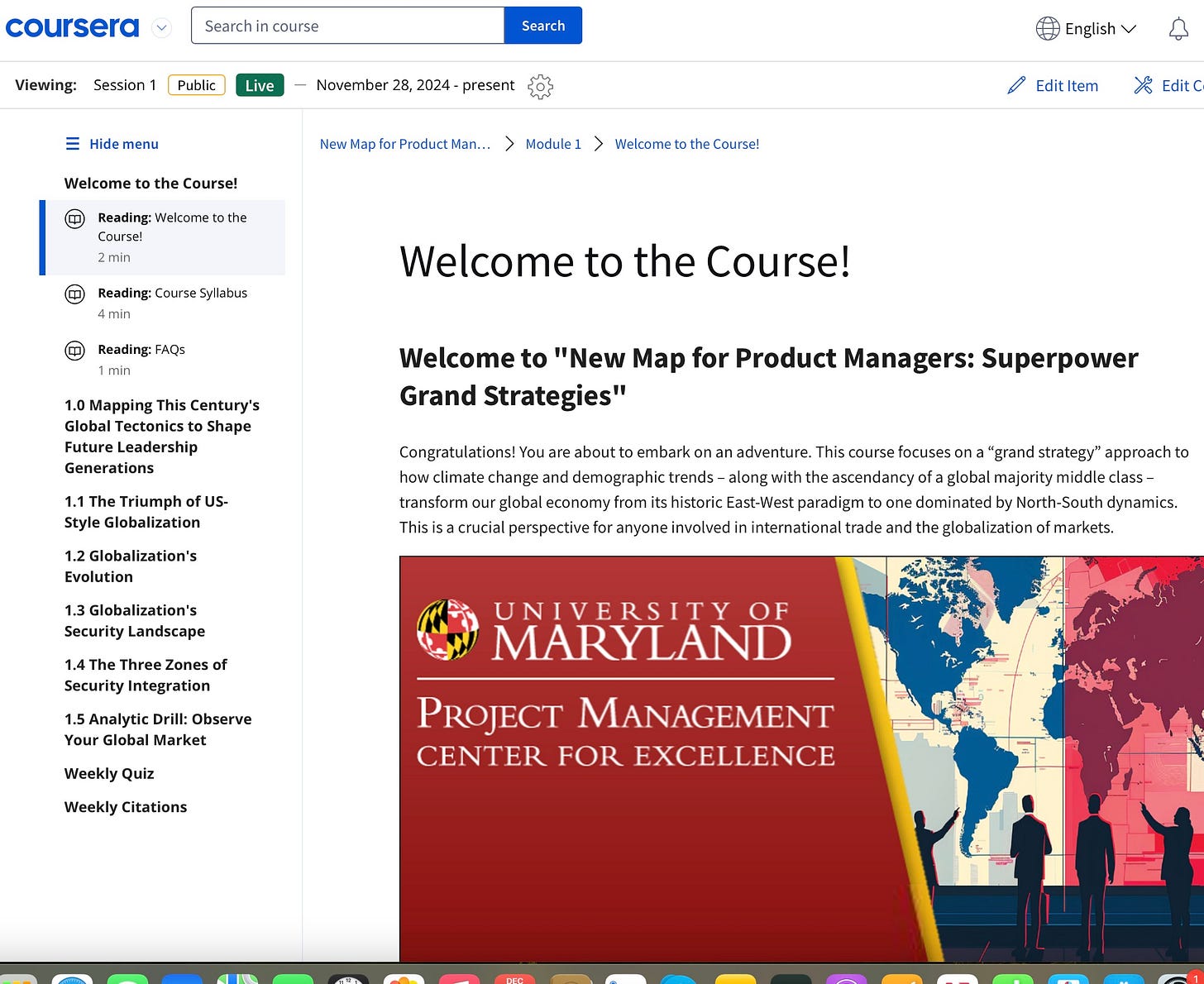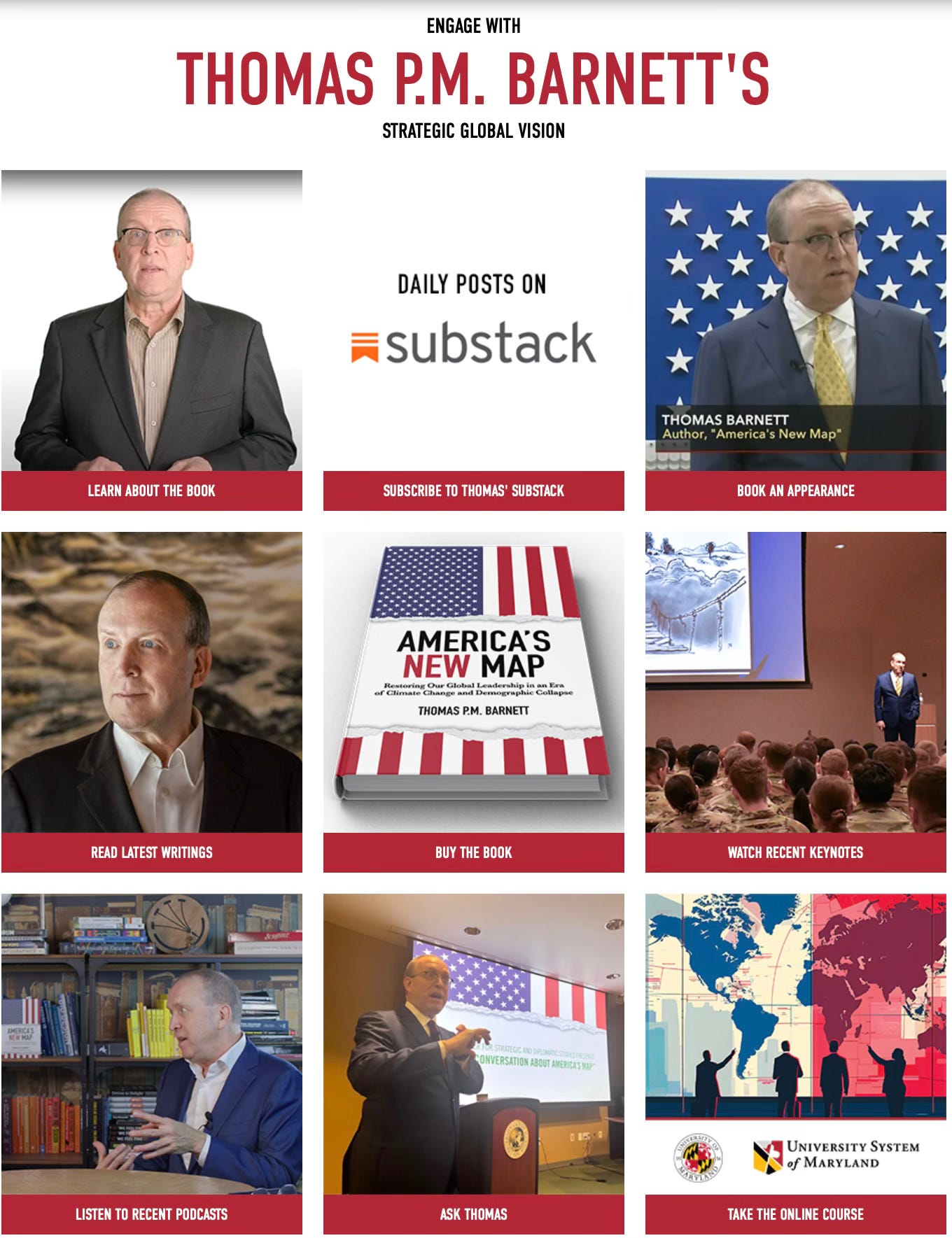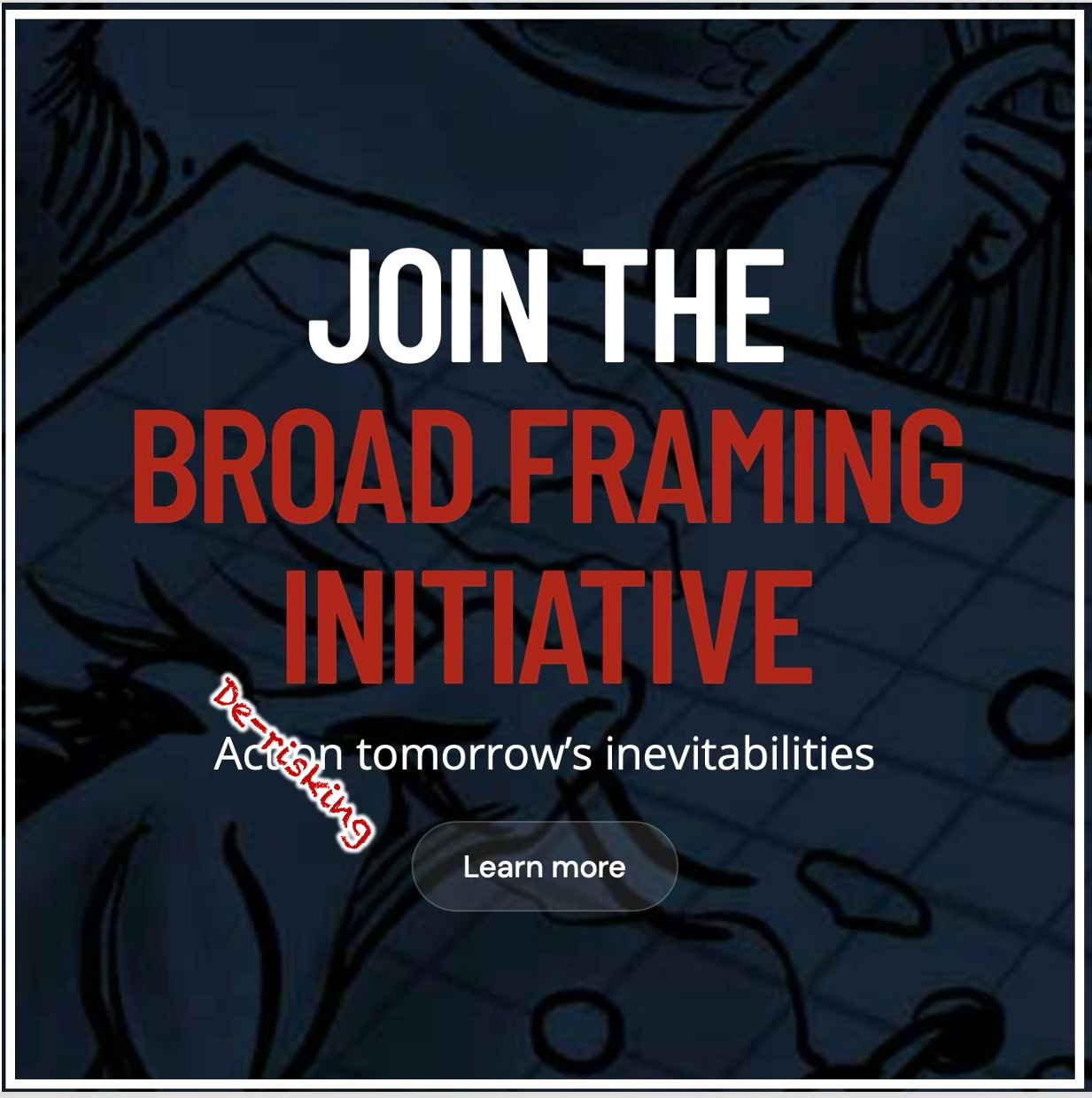Second "America's New Map" MOOC now available on edX
The first has also been just added to Coursera
As part of my being a Lecturer in Civil and Environmental Engineering at U. Maryland, I am excited to note that the second in the series of America’s New Map-inspired courses is now up on edX, in part yielding a certificate across ultimately a three-course program on edX and Coursera..
To remind on the first course up on edX:
It’s pretty much the book as a course:
About this course
This course promotes a “grand strategy” approach to how climate change and demographic trends – along with the ascendancy of a global majority middle class – transform our global economy from its historic East-West paradigm to one dominated by North-South dynamics. This is a crucial perspectives for anyone involved in international trade and the globalization of markets.
The world economy is undergoing three structural changes, each of which are enough – on their own – to define a new era of globalization . The first is climate change, which decimates lower latitudes (developing countries), denying them the benefits of globalization, while paradoxically empowering higher latitude global markets. The second is demographic aging unfolding at great rapidity across America, Europe, and Asia (Japan in particular). The third is the ascendancy of a majority global middle class whose huge resource requirements, per economists of all stripes, will drive future global economic growth – if this South-centric mass of humanity can successfully navigate climate change’s devastating impact.
Put them together and the world trade is facing an unprecedented tilting of its geopolitical axis from one historically oriented East-West to one dominated by North-South dynamics (e.g., mass northward migrations by climate refugees [see the US-Mexico border today]). The world’s 21st-century superpowers (United States, European Union, Russia, China, India) will thus compete in helping smaller powers survive and navigate these world-restructuring dynamics, in effect entering into a superpower “brand war” to win (first) economic and (then) political allegiance from among these more vulnerable nation-states.
In this new form of competition – one that will unfold as much in the cyber realm as the real world, superpowers will seek to address the majority global middle class’s quest for stability, prosperity, and security. Having achieved consumer status for the first time, these billions, largely centered in the Global South (per World Bank statistics), will naturally be attracted to those superpowers most adept at creating a sense of geopolitical “belonging” in larger unions anchored by their large financial markets that facilitate their export-driven growth. We are already witnessing this strategic offering in processes like the EU’s state-accession model and China’s Belt and Road Initiative — despite the recent increase in trade barriers (tariffs) and their effects on international markets.
Employing a “grand strategic” perspective, this MOOC is the first to explore that cluster of tectonic changes as they transform our world, offering competitive advantages to some international businesses while generating lessons and understanding for anyone involved in information technology, economic policy, foreign markets, and foreign direct investment.
Scientists estimates that species the world over are forced by climate change to increase their evolutionary speed by roughly 10,000 times. The same will be true of humans and all their enterprises: reconfiguring national borders, disrupting labor markets, reshaping capital markets, triggering financial crises, altering how and why multinational corporations engage in outsourcing, and altering global capitalism and its free trade rule-set to its very core.
In combination, climate change, demographic transitions and the emergence of a global majority middle class alter the very nature of economic activity this century (liberalization of investments, role of trade agreements, strategic partnerships among great powers), sending different countries down wildly different paths that beg the question: Exactly what is globalization going forward?
In sum, if broad-framing macroeconomic change is a skill-set you want to master, this course lays the groundwork for your understanding of how globalization affects us all by altering our planet, transforming our societies, and recasting this world order of American creation.
The first course unfolds as follows:
Week One: The Inevitabilities Humanity Faces This Century
How US-style globalization swept the planet and remade it
How modern globalization has evolved since World War II and where it’s going next
Understanding the current global security landscape
How the world is shaping up into three zones of North-South integration
How to observe your enterprise’s standing in whatever “market” defines its domain
Week Two: Forecasting the Coming North-South Integration
The dawning of the Anthropocene Epoch and how it remakes our planet
Pitting Middle Earth (lower latitudes) versus the New North (higher latitudes) on security
The demographic transition explained
The national imperative to “cash in” a demographic dividend – and what that costs
How to orient your enterprise’s future amidst these tectonic global dynamics
Week Three: Who Will Rule the Global Majority Middle Class?
The superpower brand wars to capture the loyalty/allegiance of the global middle class
The different superpower integration and regulatory models
The differing competitive styles of the five superpowers
The defining superpower struggle in the cyber realm
How to decide where your enterprise needs to go in the coming years/decades
Week Four: How the Western Hemisphere is primed for North-South Integration
Why the Americas will “win” by coming together in larger unions
How America can lose the superpower competition due to its internal “demons”
An America's-First Strategy targeting hemispheric integration
How America – and your enterprise – need to act to actualize North-South integration __
Reviewing the course and previewing the subsequent MOOC exploring the strategic business principles revealed by this grand strategic analysis.
The follow-on MOOC just up on edX
Here’s the description of the first three weeks, which is all me and all new or post-ANM material:
About this course
Geopolitical risk is consuming more and more attention across the C Suite, forcing international businesses to rethink their marketing strategies as the benefits of globalization are called into question by superpowers determined to dominate large parts of the world coming under unprecedented strains of climate change, demographic aging, and the rise of a majority global middle class. As superpowers wage their national-brand “wars” across target markets, learn how to apply your own globalization strategy to create competitive advantage across these geopolitical boundaries. Accommodate near-shoring initiatives by leveraging north-south supply chain integration to secure local markets while maintaining global brands that can access and disrupt foreign markets through business models that respect cultural differences while achieving economies of scale. Such a multi domestic strategy is essential to avoid geopolitical lock-out from different markets subject to ever increasing superpower competition among China, India, Russia, the United States, and the European Union The internationalization of these rivalries is a defining characteristic of the global economy today, meaning your enterprise’s international strategy must account for them across international markets.
The first week will be a quick overview of Course 1 content, emphasizing the three “inevitabilities” (exploding global middle-class consumption, harshening climate crises, accelerated demographic transitions) along with three “inconceivable” strategy adjustments (recognizing the supremacy of North-South tensions, navigating superpower brand wars, enabling North-South political integration). Breaking down the world into 8 specific regions, the course explores the predominant political regime-type in each. It also maps out superpower influence networks across the regions, first militarily and then in terms of diplomatic soft power. We then explore how the West (US, EU) seek to protect the international rules-based order through economic sanctions (sticks), while China pushes a “carrot-heavy” approach to win over client states with its Belt and Road Initiative.
In Week Two, the course focuses on superpower economic influence networks, starting with an exploration of how open each of our eight world regions are to external trade and then measuring how central individual superpower markets are for those regions’ exports. We then examine three advanced-to-emerging-market financial flows: Official Development Assistance, migrant worker remittances, and foreign direct investment, establishing in each region which superpowers either possess historical dominance or seek it today. Then, by profiling seven strategic markets in terms of their global supply chains, we establish how our five superpowers rank in terms of dominating global value chains while nonetheless becoming strategically dependent on various world regions.
In Week Three, the course leverages all the political-military and economic analyses of the first two weeks to profile each of the eight world regions as to how our superpowers either enjoy or seek strategic influence and standing. By doing so, we reveal each superpower’s weaknesses and ambitions vis-à-vis one another and elucidate how each seeks to address that combination through its global influence networks. At this point in the course, each student will have a solid sense of how superpower competitions are playing out in every world region, thus shaping the trade and investment market in each instance.
At that point, my colleague at U Maryland, John Clay Elliott Johnson, has just added a fourth week on brand management and will add a bonus fifth in January, ultimately comprising this syllabus:
TAUGHT BY ME
Week 1: Geo-Political Environment for Superpower Brand Wars
Breaking down world regions by types of political regime
Global military influence networks
Mapping global soft-power influence networks
China’s Belt & Road Initiative versus Western sanctions
Summing up the superpower geo-political influence competition
Week 2: Trade and Investment Spheres of Superpower Competition
Superpower trade centrality in regional markets
Superpower money flows (a): Official Development Assistance and migrant remittances
Superpower money flows (b): Foreign Direct Investment (FDI)
The complicating factors of strategic markets trade
Summing up the superpower economic influence competition
Week 3: Region-by-Region Guide to Superpower Brand Competition
North America & Latin America
Europe & Former Soviet Union/Commonwealth of Independent States
Middle East/North Africa & Sub-Saharan Africa
South Asia & East Asia
Summing up superpower brand competition
TAUGHT BY JOHN
Week 4 - Navigating Global Categories
Brands and Products in a Global Econom
Strategic Goods and Materials
Luxury Brands
Trusted Consumer Brands, Goods, and Services
Commodities and Manufacturing
BONUS Week 5 - Regional Strategies and Success Stories
America - Nearshoring via NAFTA/USMCA
EU - Strategic Positioning for Growth and Compliance
China and East Asia - Navigating Roadblocks with a Fast Follower Model
India - Harnessing a Runaway Talent Train
Africa - Groundflooring and Market Making
A third course to complete the certificate program is in the works for spring 2025.
The total certificate reads as:
With the ultimately three courses demarcated as:
Coursera
Let me also note that the first of the series is already up and available on Coursera, with the second one going up any day now.
I contemplate future courses on strategic thinking more generally, ideally collaborating with a colleague of mine out of Syracuse.
All in all, very fun stuff to create and to share around the world.
On edX, we’re approaching about one-thousand students across the three course, with the strong plurality hailing from India (about 25-30%), followed by the US and UK (another 30% or so), and then about 5 dozen other countries represented (64 countries in all).
The geographic spread on the first course looks like this:












